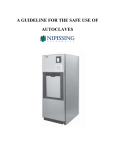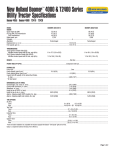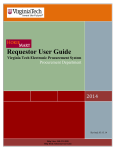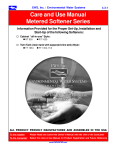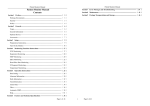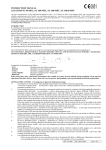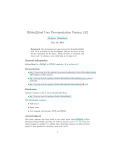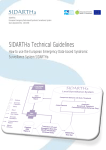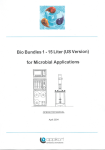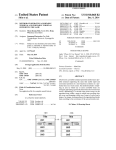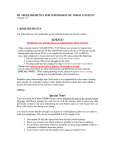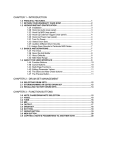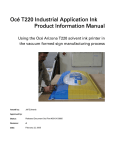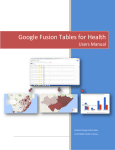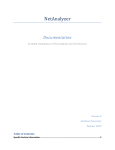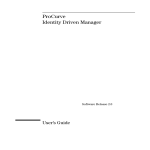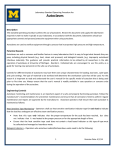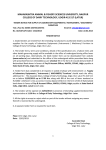Download a guideline for the safe use of autoclaves
Transcript
A GUIDELINE FOR THE SAFE USE OF AUTOCLAVES UNIVERSITY OF OTTAWA Environmental Health and Safety Service Last date of revision July 9, 2003 TABLE OF CONTENT 1.0 PURPOSE . . . . . . . . . . . . . . . . . . . . . . . . . . . . . . . . . . . . . . . . . . . . . . . . . . . . . . . . . . . . . 1 2.0 INTRODUCTION 3.0 PERSONAL PROTECTIVE EQUIPMENT . . . . . . . . . . . . . . . . . . . . . . . . . . . . . . . . . . 2 4.0 TRAINING . . . . . . . . . . . . . . . . . . . . . . . . . . . . . . . . . . . . . . . . . . . . . . . . . . . . . . . . . . . . 2 5.0 ITEMS FOR AUTOCLAVING ( THE CANS AND CAN NOTS ) . . . . . . . . . . . . . . . . 3 6.0 LOADING AN AUTOCLAVE . . . . . . . . . . . . . . . . . . . . . . . . . . . . . . . . . . . . . . . . . . . . . 3 ....................................................1 ( Packaging, Identification, Transporting Packaged Material to the Autoclave, Fundamentals of Loading to Ensure Success ) 7.0 OPERATING AN AUTOCLAVE . . . . . . . . . . . . . . . . . . . . . . . . . . . . . . . . . . . . . . . . . . 9 (Autoclave Technology and Cycles, Factors to Consider, Determining the Correct Cycle Time, Cycle Failure ) 8.0 UNLOADING AN AUTOCLAVE . . . . . . . . . . . . . . . . . . . . . . . . . . . . . . . . . . . . . . . . . 12 9.0 DISPOSING OF AUTOCLAVED WASTE . . . . . . . . . . . . . . . . . . . . . . . . . . . . . . . . . . 13 10.0 STORAGE OF WASTE AWAITING AUTOCLAVING . . . . . . . . . . . . . . . . . . . . . . 13 11.0 RECORD KEEPING . . . . . . . . . . . . . . . . . . . . . . . . . . . . . . . . . . . . . . . . . . . . . . . . . . . 14 12.0 PREVENTIVE MAINTENANCE . . . . . . . . . . . . . . . . . . . . . . . . . . . . . . . . . . . . . . . . . 14 (Daily / weekly maintenance activity, annual maintenance activity) 13.0 QUALITY CONTROL . . . . . . . . . . . . . . . . . . . . . . . . . . . . . . . . . . . . . . . . . . . . . . . . . 15 14.0 MISTAKES IN AUTOCLAVING . . . . . . . . . . . . . . . . . . . . . . . . . . . . . . . . . . . . . . . . 17 15.0 REFERENCES . . . . . . . . . . . . . . . . . . . . . . . . . . . . . . . . . . . . . . . . . . . . . . . . . . . . . . . 19 16.0 CONTACT INFORMATION . . . . . . . . . . . . . . . . . . . . . . . . . . . . . . . . . . . . . . . . . . . . 19 Appendix 1 Training Record . . . . . . . . . . . . . . . . . . . . . . . . . . . . . . . . . . . . . . . . . . . . . . . . . 20 Appendix 2 Daily Autoclave Use Log . . . . . . . . . . . . . . . . . . . . . . . . . . . . . . . . . . . . . . . . . . 21 Appendix 3 Biological Indicator Test Results . . . . . . . . . . . . . . . . . . . . . . . . . . . . . . . . . . . 22 Appendix 4 Autoclave Performance Record . . . . . . . . . . . . . . . . . . . . . . . . . . . . . . . . . . . . 23 Appendix 5 The 1, 2, and 3's of Autoclaving . . . . . . . . . . . . . . . . . . . . . . . . . . . . . . . . . . . . 24 1.0 PURPOSE The purpose of the “Guideline for the Safe Use of Autoclaves” is to inform potential users and their supervisors of the issues that must be considered to ensure the autoclave process is undertaken in a safe, effective and efficient fashion. It is important to recognize that specific faculties and departments may have more stringent operational requirements in place to meet their own needs. In addition, many of the autoclave facilities have dedicated individuals who are delegated the task of ensuring the autoclave is used properly, maintained regularly, quality assurance standards are met, and users are trained. You are therefore required to meet with these individuals prior to using an autoclave. Should you have difficulty identifying the appropriate individual in your faculty or department contact EHSS for assistance. 2.0 INTRODUCTION As previously stated, this guideline is designed to assist you in understanding the intent and limiting factors associated with the use of an autoclave when decontaminating biohazardous or potentially biohazardous material, or sterilizing solids and liquids. An autoclave is a specialized piece of equipment designed to deliver heat under pressure to a chamber, with the goal of decontaminating or sterilizing the contents of the chamber. Decontamination is the reduction of contamination to a level where it is no longer a hazard to people or the environment. While sterilization is the total destruction of microorganisms present. This is achieved because heat damages the cell’s essential structures, including the cytoplasmic membrane, rendering the cell no longer viable. This will only occur if the material is heated to a specific temperature for a given period of time. These parameters will vary depending upon the nature of the microorganisms present and the characteristics of the load itself. To facilitate this transfer of heat, moisture is often added; but this does not guarantee success. A number of other factors must be considered. This guideline will outline these in greater detail, as each step in the process is discussed. 3.0 PERSONAL PROTECTIVE EQUIPMENT 1 Due to the fact that autoclaves utilize steam, heat and pressure the risk of personal exposure and potential harm is great. Therefore one must wear the appropriate protective equipment. Often material to be loaded contains potentially infectious material, so the standard laboratory protective equipment must be worn. This includes: S safety eye and face protection (face shield minimizes the risk of facial steam burns), S gloves (latex or nitrile gloves prevent contact with contaminated material, while heat resistant gloves (asbestos free) must be used when loading and unloading the autoclave), S lab coats ( long sleeves must be used to protect wrists and forearms, plus an apron if a spill hazard exists). Remember that although the autoclave trays may be cool, the door and walls of the chamber may still be hot enough to cause a burn! 4.0 TRAINING Training is absolutely required prior to using the autoclave. Not only will this minimize the risk of personnel being harmed, but it is essential to ensuring a successful decontamination or sterilization of your material. Training will also help minimize the risk of damage to the equipment. This guideline is one tool to assist in training. In addition, you must receive training specific to the autoclave you will be using. This will assist you identifying problems with your own load or previous loads, i.e., interpretation of cycle log records. Thus training will help promote: S safety, S research quality, and S optimal use and care of equipment. All principal investigators and supervisors should document that this training has been received by their 2 staff (students and support staff) who will be using the autoclave. (See Appendix 1) 5.0 ITEMS FOR AUTOCLAVING (THE CAN AND CAN NOTS ) Although autoclaving provides an economical way of sterilizing and decontaminating items, not all material can be autoclaved. Some materials present specific hazards when they are autoclaved; such the generation of toxic /noxious gas. To help you identify what may or may not be autoclaved a general list of items has been included in this guideline. Items that CAN be autoclaved are: S cultures and stocks of infectious material S culture dishes and related devices S S S discarded live and attenuated vaccines contaminated solid items such as: petri dishes, eppendorf tips, pipettes, gloves, paper towel items for sterilizations such as; glassware, media, aqueous solutions, equipment Items that CAN NOT be autoclaved are: S materials containing: solvents, volatile, chlorinated compounds (HCL, bleach)or corrosive chemicals (such as: phenol, trichloroacetic acid, ether, chloroform) etc. S material contaminated with chemotherapeutic agents S radioactive material (without prior approval) S some plastics 6.0 LOADING AN AUTOCLAVE This section will address the various steps to be undertaken when preparing and autoclaving the material to be decontaminated or sterilized.. The following factors will be discussed: packaging (primary and secondary), identification requirements, and the fundamentals of loading an autoclave to maximize steam penetration. Each of these play a critical role in ensuring a successful decontamination /sterilization. 3 Prior to Loading an Autoclave: Verification should be undertaken to ensure the autoclave has been functioning correctly and has been meeting the validation requirements. This verification can be performed by: 1) reviewing the previous cycle log recordings, 2) examining the results of the daily* verification records, and 3) speaking to the individual responsible for the autoclave. For additional information, please refer to the quality control section of this guideline. * unless otherwise authorized by EHSS Packaging As the success of the decontamination /sterilization is dependent upon the penetration of heat; how material is initially prepared will greatly affect the outcome. Consideration must be given to the primary container (containing the contaminated waste), volume of liquid, amounts of material, and the secondary container (containing the primary container). Primary container Secondary container The structural integrity of the container is an important consideration. Not all containers withstand the demands placed on them during the autoclave process. Desirable characteristics are heat resistance, good thermal conductivity, puncture proof and impervious to water. 4 Good Choices: S borosilicate glass (Pyrex) has very low thermo expansion property and therefore S S resistant to breaking due to heating polypropylene (PP) and polycarbonate (PC) are heat resistant plastics stainless steel is a good heat conductor and thus facilitates sterilization S polystyrene (PS), polylethylene (PE) and high density polyethylene (HDPE) do not S resist heat well. if there is a risk of material melting ensure they are placed in a secondary container Poor Choices: which is resistant to heat. Most containers will identify the type of plastics identified on the base of the container with the appropriate initials imprinted. (PP, PC, PS, PE, HDPE, LDPE...) Prior to autoclaving, separate material for re-use from that which will be disposed. This will have the benefit of: preventing re-handling and therefore minimize the risk of contamination, reducing the risk of personal injury due to sorting of sharp objects, and finally avoiding having to separate items that have become stuck together during the autoclaving process. When packaging the material, consideration must also be given to the final weight of the items, taking into account possible water absorption during the autoclave cycle. Total weight must not exceed the load bearing restrictions of autoclave, or cause ergonomic injuries as a result of transferring this material in and out of the autoclave. It is recommended that water to the depth of 2.5 cm be added to the pans containing glassware. This will to fill insulating air pockets that may be generated when the glassware is placed in the pan. (This apparently is not such a concern for metal pans.) In addition to insulating properties, these pockets are believed to play a role in glassware breaking. The addition of water will also help minimize the quantity of material that may be baked on to the surface. Add 250 mL of water to the contents of bags containing solids (more if the bag is large). This will create additional steam which will displace the dry air from the bag, increasing the rate of heat penetration. It is best to allow the water to drain down the sides of the bag, taking care to avoid splashes and/or spillage. 5 Primary Container: The primary container is the container which comes into direct contact with the contaminated material of fluid. This may include such items as: flasks or vials holding liquids (either media or infectious material), wrapping paper or muslin protecting instruments, and biohazard bags containing waste. This packaging must permit heat (steam) penetration, and ensure pressure differentials are not created as this will result in breakage. (No sealed containers must be placed in an autoclave!) This may be accomplished by using techniques such as: S loosening screw caps or using self venting caps. S capping open containers for sterilization with aluminum foil S using envelope folds for wrapping kraft paper or muslin (This has the added benefit S of protecting contents from contamination during the opening process.) opening plastic bags slightly prior to loading them into the autoclave. Autoclave Bags: The classic autoclave bag is made of polypropylene (PP) and is strong and puncture resistant. These bags come in a variety of sizes and with or without labeling. Although these are excellent qualities, there is a draw back; polypropylene does not have good steam permeability. To facilitate the steam transfer one can open the bag prior to autoclaving and add water to the contents to generate steam from within. Although not recommended for general use, polyetheylene (PE) may also be used for autoclaving, as it has greater steam permeability. Studies have shown that PE packaging accelerates load heat-up, which in turn increase the efficiency of the sterilization. But care and diligence must be demonstrated when using this material for packaging as it has very poor heat resistance and will melt. To address this a PE bag can be used as a primary container and then doubled bag using an outer PP bag. This outer bag must then be rolled down somewhat to allow steam penetration, but still allow for the containment of the PE bag after heating. In addition a tray must be used to hold both bags, to prevent any mishap with melted PE collecting in the base of the autoclave chamber. Another factor that must be considered is that the melted PE bags can inadvertently seal the ends of pipets or cause other insulated pockets to exist. This will result in decrease heat/steam penetration. 6 In conclusion: PP bags are the preferred selection of bag for most material. When special circumstances arise and the load composition is taken into account, PE bags inside PP bags can be used to increase steam penetration. Volumes / Amounts As volume and density will impact the heat transfer and steam penetration it is important not to fill the containers beyond the 75% of the holding capacity. This also allows for liquid expansion, preventing overflow. Similarly with solid material, the additional available volume will allow the contents to shift during transfer into a secondary container or the autoclave without spilling out of the bag. Avoid packing or compressing the contents to achieve volume limits as this will restrict steam penetration. Secondary Containers The sides of the secondary container must be sufficiently high to contain any spill that may occur. It is recommended that secondary containers of both 15 cm and 30 cm be available. Extreme care must be taken to ensure they are capable of with standing the demands of the autoclave procedure. Age of pans can often cause them to become brittle or to soften when heated. Regular inspection of the secondary container will help identify compromised containers. In addition, they should be made of material that facilitates the transfer of heat to compensate for the restricted airflow within the chamber caused by their presences. This becomes much more a factor with the 30 cm high containers. Nice and Neat ! Good use of secondary container But one of those primary container bags is over filled and is too big! Identification It is necessary to label all material being placed in the 7 autoclave. This is important for the following reasons: 1) so the material may be subsequently sorted and returned to the appropriate laboratories, 2) should a problem or concern arise regarding the function of the autoclave the individuals potentially affected may be informed, and 3) should a spill occur the risk may be assessed based on the contents involved. Remember you may not be aware of a problem until much later in your research project, for example: contaminated cell cultures. Therefore the following information must be affixed: 1. name of responsible person 2. contact information 3. identification of contents (including volume of liquid contained.) Use of Temperature Sensitive Tape: Temperature sensitive tape must be affixed to bags and each individual item. When this tape has been exposed to high temperatures lines will appear. Thus it may be used to indicate that the labeled material has been autoclaved. It is not proof that the autoclave cycle was successful at decontaminating or sterilizing the contents. A biological indicator or other means must be used to act as a quality control validator. Transporting Packaged Material to the Autoclave When transporting material to be autoclaved, use a cart with guard rails. Ensure the use of a secondary container to collect any spillage should the cart be knocked or jarred during transport. Use a direct but not heavily populated route. Surface decontaminate the container prior to transport, unless there is no risk of contamination. This waste should be restricted to laboratory zones and not areas used by the general public. Should this not be possible contact the EHSS for advice. Fundamentals of Loading To Ensure Success As much attention must be applied to loading the autoclave, as was given to packaging. Again the determining factor is ensuring heat/steam penetration. Therefore care must be given to avoid overloading the chamber, placing bags in the chamber which are too large, or adding too much weight which will tax the design elements of the autoclave. Consideration must also be given to ergonomic factors. Simple measures can be used to ease the flow of heat and steam thorough and into the contents of the 8 containers. Here are some fundamental rules : 1. Load the material in such a fashion to present the least resistant passage of air exchange through the load, from the top of the chamber to the bottom. 2. Avoid crowding or stacking. 3. Place packages on their edges to enhance steam penetration, place a rack or other item against these items to prevent them from slipping. 4. For loads which are mixed (fabric and hard goods) place the hard goods on the bottom to prevent possible condensation from dripping on to the fabric. 5. Place empty flasks, test tubes or other non-porous containers on their sides with loose covers. This provides a horizontal pathway and prevents trapping air pockets. 6. Ensure containers do not touch each other, this will ensure all surfaces are sterilized. 7. No items should touch the top or sides of the autoclave container as the container is pushed inside. 8. Liquids and dry goods are processed separately as they require different cycle selections. 9. A load of liquid filled containers should be of similar size, shape, content and volume; because exposure time is based on these characteristics. 10. Run material to be sterilized separate from those to be decontaminated. 7.0 OPERATING AN AUTOCLAVE Autoclave Technology and Cycles There are three technologicalprocesses associated withautoclaving material and are based on the following design elements: gravity, pre-vacuum, and isothermal. Gravity The gravity design is utilized for sterilizing non-porous heat and moisture stabilized goods. These included liquids and media and solids such as laboratory waste. Pre-Vacuum The pre-vacuum increase the speed and efficiency associated with sterilization. It expands the capability of the gravity design by its ability to sterilize porous heat and moisture stabile materials; such as animal bedding. 9 Isothermal This design addresses the need to sterilize at lower temperatures for the heat sensitive and heat coagulable material: such as infant formula or media. The isothermal process is usually used for pasteurization, inspissation, or fractional (intermittent) sterilization. Each process have a variety of cycles that may be employed and are dependent upon the process, or options associated with each autoclave. These include: heat, gravity, pre-vacuum, sterilize, exhaust, dry. Exhaust may either be undertaken rapidly or slowly. The rate of exhaust will depend upon the nature of the load. Dry material will permit a fast exhaust, while liquids require slow exhaust to prevent boiling over of super-heated liquids. Refer to the autoclave manual to obtain a complete description of the cycles available. Factors to Consider Each autoclave will have specific instruction for its own use. It is important to follow the manufactures recommendation and each user must receive hands-on training on its use. Although many factors must be considered when determining the length of time required some general guidelines can be provided. Factors that will affect your cycle times will be: S if the autoclave will be used for sterilization or decontamination S manufactures recommendation for media sterilization S if the material is primarily solid or liquid S volume of liquid S shape and size of containers used S thermo conductivity properties of the container S viscosity of the liquid S density of the material S position of the load within the autoclave chamber To be effective the autoclave must reach and maintain a temperature of 121-123 minutes. This is achieved by using saturated steam under at least 15 psi of pressure. O C for at least 30 It is important to recognize the length of time required to achieve this temperature will be dependent upon the factors stated above. In addition the sensing device which records this temperature is not located within the load of material being autoclaved. Therefore additional time may be required to ensure the centre of the load has achieved this temperature, for examples with samples that have a very high biological load the contact time must be extended to 60 minutes. 10 Determining the Correct Cycle Time As the cycle time will vary with the composition of the load, it is important to determine the appropriate time requirement. Assuming the minimal time of 30 minutes, may prove to be a very costly mistake. Therefore: S S select the typical bag size and contents place the biological indicator in the centre of the load. Attach a string or tape to it to S S S allow easy retrieval. run the autoclave using the typical cycle selection retrieve the biological indicator and process as per manufactures instructions if the indicators turns yellow the autoclave process has FAILED S S increase the cycle time by 15 minutes and retest retest until the indicator proves a successful autoclave cycle. PASS is indicated by no colour change, and hence no bacterial growth. Cycle Failure If the autoclave cycle fails to be completed, the load must be re-autoclaved. This may be achieved by switching the autoclave to the manual cycle (if available). If the failure was due to a power outage the cycle may not be initiated again until power is restored throughout the whole grid system or emergency power has been activated. Refer to the manual for detailed instruction specific to your autoclave. 8.0 UNLOADING AN AUTOCLAVE The greatest risk of personal injury occurs during the process of unloading the autoclave. Not only is the risk of burns or scalding significant, but one may also be exposed to the vapours and gases generated by the inadvertent autoclaving of volatile chemicals. Super-heated liquids also pose of risk of exploding if they are shaken or moved during the cooling process. In addition glassware can break if the autoclave door is opened too quickly, and sufficient time is not provided for them to approach room temperature. Consequently, extreme caution must occur during this final stage. Procedures to follow: 11 1. Wear all necessary personal protective equipment. 2. The chamber pressure gauge of the autoclave should be zero before opening the autoclave’s door. 3. Crack door slightly and stand back to allow steam to escape. To minimize the risk of accidents caused by steam escape, the person who opens the autoclave door should stand directly behind it. 4. Slowly open autoclave door. Opening the autoclave door too quickly may result in glassware breakage and/or steam burns to the skin. 5. If boiling or bubbling is present, wait until it subsides. Assess the risk of super-heated liquids. 6. Over exposure of saline or water is not a critical factor (as it is with media), so these liquids may be allowed to cool (for 10 min.) in the autoclave after cracking the door to release the steam. This is also recommended for all other items. 7. Bring the autoclave trolley to the chamber. 8. Using heat resistant gloves, carefully transfer the containers (pans) to the trolley. Be careful not to jolt the containers as it could result in breakage. 9. Move the containers to a draft free area. 10. If not already cool wait 10 minutes, prior to storing sterilized material or preparing autoclaved waste for disposal. 11. After every use, it is advised to close the autoclave door but do not seal the door as this will shorten the life span of the rubber gaskets on the door. 12. Verify that the temperature sensitive tape has changed color, or diagonal lines or the words “autoclaved” has appeared. If no change appears on the tape, the load is required to be re-autoclaved after placing new tape on the material. Also verify the cycle log recorder to check the temperature and time attained. If minimum time and temperature is not attained on the second cycle, users should contact the person responsible for maintenance of the unit to initiate repairs. Leave a note on the autoclave stating the problem and the it can not be used until problem has be resolved. 13. The container that could be contaminated by a liquid splash (due to boil over) or by direct contact with contents of the waste bag (such as melted agar) should always be washed after each use. 9.0 DISPOSING OF AUTOCLAVED WASTE 12 Once the waste has been successfully autoclaved, the waste is no longer considered biohazardous. It may now be disposed of to the appropriate municipal waste stream. It is now important to alter the hazard awareness signage and symbols to reflect this. This should be undertake in two ways. 1. Using a large felt marker deface the biohazard symbols. 2. Apply the University of Ottawa label which indicates that this waste is “Autoclaved Biomedical Waste - Non- Hazardous”. Once this has been accomplished the defaced and labeled autoclaved waste bags should be placed inside a plastic trash bag (black) designed for domestic applications. It is greatly recommended to place only one or two biohazardous bags inside a single plastic trash bag (domestic applications) to prevent an overload and to minimize the risk of breakage. Ensure the black bag is securely tied close. 10.0 STORAGE OF WASTE AWAITING AUTOCLAVING Often it is necessary to wait for the previous autoclave cycle to end prior to autoclaving your own load. When this is the case, the waste should be stored in a safe, dry and secure place. This is to minimize the risk of personnel and animals being exposed, and to avoid the inadvertent disposal of the waste prior to autoclaving. The waste must be appropriately labeled (name, telephone number, content). A secondary container must be used to collect any seepage that may occur. The bag must be sealed and placed in such a fashion to prevent it tipping over. Do not seal the bag in such a fashion as to prevent it being re-open (slightly) to permit steam penetration during autoclaving. Waste should be stored for the minimal length of time in an autoclave facility, a couple of days at the maximum. If significant bio-degradation or strong odours are likely to occur, another storage venue must be identified. Should waste not be autoclaved within 2-3 days contact the individual responsible for the autoclave or EHSS. 11.0 RECORD KEEPING 13 Records are a vital component of the autoclave process. These records act as historical proof that the autoclave has been meeting the regulatory requirements and/or industrial standards. Three types of records are to be kept: 1. Autoclave Log S which identifies the users, nature of the load, cycles used and exposure times (See Appendix 2) 2. Validation Records S record the results of the validation activities undertaken. This would include the results of the daily* biological indicator. (See Quality Control and Appendix 3) 3. Performance Records S records the dates that problems were encountered, remedial action taken and any service calls required. (See Appendix 4) In addition, annual service reports should be kept. This record will permit a general assessment of the condition of the autoclave; and helps to answer the question “Should we be considering replacing this autoclave in the next 3-5 years?” * unless otherwise authorized by EHSS 12.0 PREVENTATIVE MAINTENANCE Preventative maintenance will greatly increase the efficiency of your autoclave, reduce downtime and save costly repairs. It may be considered as a scheduled inspection, which could result in minor adjustments or repairs, major repairs, or premature replacement of parts. It is designed to maintain safety, and delay or avoid an emergency. The work associated with this activity is greatly reduced when: the autoclave is used properly, the loads are packaged and loaded in an appropriate fashion (to minimize the risk of spills and explosions, and material touching the chamber walls), and secondary containers are used to collect spills. Daily / Weekly Maintenance Activity: Although the manual will provide specific instructions some general guidelines can be provided. Steps that should be taken daily or weekly, depending upon use pattern and control during packaging and loading, are: 1. Disinfect exterior surfaces of the autoclave 14 2. Check door gaskets for wear 3. Clean interior walls withtrisodium phosphate, other mild detergent or as recommended by the manufacturer. Never use a strong abrasive or steel wool. Rinse with tap water after cleaning. 4. Clean screen leading to discharge line 5. Check primary and secondary containers for integrity (stress fractures, cracks, chips etc.) 6. Consult manual to determine other recommended activities Yearly Maintenance Activity: An annual inspection and maintenance program should be undertaken by qualified individuals. 13.0 QUALITY CONTROL A number of tools are available to assess the performance of the autoclave; these include physical, chemical and biological indicators. It is important to note that these indicators will only respond to time, temperature and moisture conditions, and not to organic load. Physical Indicators: Pressure and temperature recording devices. Thermocouples can be placed inside the load to determine the temperature achieved in the bag itself. Chemical Indicators: These indicators change colour after being exposed to specific temperatures, for example: heat sensitive tape. Upon exposure to the given temperature the change will occur; it is not time related. Therefore these indicators can only attest to the temperature attained and not to exposure time and hence success of sterilization. Biological Indicators: Biological indicators are used in the efficacy testing of the autoclave process to effectively sterilize the contents being treated. Bacillus stearothermophilus spores are used, as they are the most resistant organism to steam autoclaving. To determine the effectiveness of the autoclave process the biological indicator must be placed in a typical test load (solid or liquid) and exposed to the typical cycle conditions. This is the standard method of validating the effectiveness of your autoclave procedures. Testing using a biological indicator must be undertaken daily, unless otherwise authorized by EHSS. Procedures: 15 1. 2. 3. 4. Read and follow the suppliers instructions. Place B. stearotheromophilus in centre of representative test load. Process load in normal fashion a) Extract and incubate B.stearothermophilus sample as instructed by b) manufacturer. Use another ampoule (same lot #) not autoclaved to act as a positive 5. control. Check for colour change at regular intervals during the incubation period 6. (8, 12, 24, and 48 hours). If media is yellow and turbid the autoclave process has FAILED. Immediately upon noting yellow colouration, re-run all samples with new biological indicators. If failure continues to be noted, either increase time of exposure or initiate 7. repairs to the autoclave. Note the autoclave can not be used again until validations procedure indicates that autoclave is now adequately sterilizing the material. Record all results. (Positive and Negative) 16 Records: (See Appendix 3) 1. Record biological indicator information: brand, lot #, expiry date. 2. Record the date, operator, cycle time, cycle temperature of the test run. 3. Record results: colour change noted (Failure), no colour change- yellow (Pass) 14.0 MISTAKES IN AUTOCLAVING A number of events (operator and mechanical) can cause the autoclave cycle to fail, but most tend to be directly related to the packaging and loading consideration taken. This may result in having to re-autoclave material, or modify the cycle conditions (length of exposure time or temperature). Unfortunately, lack of diligence during the autoclave process can be very costly in terms of: S personal injury S down time S lost experimental data S expensive and/or length repairs S inappropriate disposal to landfill resulting in regulatory violation and an inquiry/fine Typical mistakes: S insufficient personal protective equipment (resulting in injury) S rushing (resulting in burns, spills etc.) S inappropriate material selection (resulting in glassware breakage or unexpected or undesired melting of containers) S sealing containers (resulting in pressure buildup, explosions, and lack of steam S S S penetration) lack of use of secondary containers (resulting in the chamber becoming contaminated) over-filling containers (resulting in liquids boiling over and loss containment of solids) poor loading practices (resulting in lack of steam penetration through the load) 17 Autoclaving Without Using a Secondary Container Do Not Autoclave Sealed Bag 18 14.0 REFERENCES C Laboratory Biosafety Guidelines, Health Canada, 3rd Edition-Draft, Sept. 20, 2001 • Laboratory Biosafety Manual, 2nd Edition, World Health Organization, Geneva • “Using a Gravity Displacement Steam Autoclave in a Biomedical Laboratory” video produced by School of Public Health, University of Minnesota under contract with National Institute of Allergy and Infectious Disease C Cooney,Timmothy E., Techniques For Steam Sterilizing Laboratory Waste, AMSCO Research and Development C Autoclave Procedures, Office of Radiation, Chemical and Biological Safety, Michigan State University www.orcbs.msu.edu/biological/autoclave/sterilization.htm C Safety Net - Effective Use of Autoclaves, University of California - Davis, Environmental Health and Safety, University of California www-ehs.ucdavis.edu/sftnet/sn-26.html C Biological Safety Update, UCSF Autoclave Quality Control Program, University of California San Francisco, Environmental Health and Safety www.ehs.ucsf.edu/Manuals/BSMEntireDoc.htm C Medical Waste Management Program, University of California - Riverside, Environmental Health and Safety www.csuchico.edu/ehs/mwm.htm C “Procedures for Disposal of Biomedical Waste at UWO”, University of Western Ontario 15.0 FOR ADDITIONAL INFORMATION, PLEASE CONTACT: Lois Sowden-Plunkett Phone: (613) 562-5800 (3058) Manager, Radiation and Biosafety Email: [email protected] Environmental Health and Safety Service Fax : (613) 562-5211 University of Ottawa 19 Appendix 1 TRAINING DOCUMENTATION This document is to attest to the fact I,________________________________________ , have ( First name Last Name ) read the “Guideline to the Safe Use of Autoclaves” and am aware of the issues that may affect the effectiveness of autoclaving, issues to minimize personal exposure, and the requirements for documentation. In addition I have been trained with regards to the correct use and recommendations associated with the use of the specific autoclave I will be using. I have answered correctly the following questions which confirm my basic knowledge of autoclave safety related issues. Circle the correct answer. 1. The effectiveness of autoclaving is based to a large degree on the appropriate packaging and loading. T F 2. To prevent spillage autoclaving, seal all autoclave bags. T F 3. The technique used to load the autoclave does not greatly influence the success of the cycle. T F 4. All material can be autoclaved. T F 5. A change in colour of temperature sensitive tape does not indicate the material has been successfully autoclaved. T F 6. It is not necessary to use a biological indicator to test (daily*) the efficacy of the autoclave if it consistently achieves the selected temperatures. * unless otherwise authorized by EHSS T F 7. As the material has been autoclaved there is no risk associated with unloading the autoclave upon completion of the cycle. T F 8. The personal protective equipment that must be worn includes eye and face protection, gloves (including heat resistant gloves), lab coat (plus apron if spill risk). T F _____________________________ Signature of Autoclave User Date ______________________________ ________________________ Signature of Supervisor Date 20 DAILY AUTOCLAVE USE LOG Model : _____________________________ Date Name of Generator Contact Telephone No. Series : _________________________ Description of Contents 21 Name of Autoclave Operator Appendix 2 Room #: ____________ Cycle Selected Temperature Achieved (oC) Length of Time Autoclaved Appendix 3 BIOLOGICAL INDICATOR TEST RESULTS Autoclave : Make: Biological Indicator: Date of Autoclaving & Incubation ___________________ Model: __________________ Serial #: ___________________ Room #: ____________ Type: ____________________ Operator Cycle Selected & Temperature (oC) 22 Cycle Time Duration of Incubation (hrs) Biological Indicator Expiry Date & Lot # Results Pass (P) Fail (F) Appendix 4 AUTOCLAVE PERFORMANCE RECORD Autoclave Make:_____________________ Model:_____________________________ Serial #:_____________________________ Date Problem Remedial Action Comments 23 Description of Service Call Appendix 5 THE 1, 2, AND 3'S OF AUTOCLAVING WEAR PERSONAL PROTECTIVE EQUIPMENT Eye and Face Protection, Glove (including heat resistant gloves), and Lab coats (long sleeve apron) 1. Packaging and Loading < < < < < < < < < < < use approved autoclave bags prepare and load material to ensure steam penetration ensure all containers including bags are vented do not overfill containers (prevent spill and boil over) ensure sufficient water in load to allow steam penetration or add 250 mL water to bags containing solids to ensure steam penetration use secondary containers label all material (name, contact telephone number, contents) ensure material is permitted to be autoclave do not mix clean and contaminated material in the same load complete “Daily Autoclave Log” do not allow bags to touch or strap sides of autoclave 2. Operating an Autoclave < < < ensure the autoclave is operating properly before commencing determine the appropriate exposure time for the load, consider the many factors effecting exposure time ensure the autoclave attains the desired temperature(normally 121oC) and pressure (minimum 15 psi) for the desired time (minimum 30 min.) record information in “Daily Autoclave Use Log” undertake weekly testing using a biological indicator (B. Stearothermophilus. Record results on “Biological Test Indicator Results” form. < < 3. Unloading the Autoclave < < < < < wait until the chamber pressure gauge reads zero before opening open slightly to allow steam to escape (protect yourself from the steam) wait 10 minutes for the contents of the autoclave to cool. remove the waste in manner reduce the risk of spillage, use a trolley verify temperature and duration of exposure has been met. 24


























